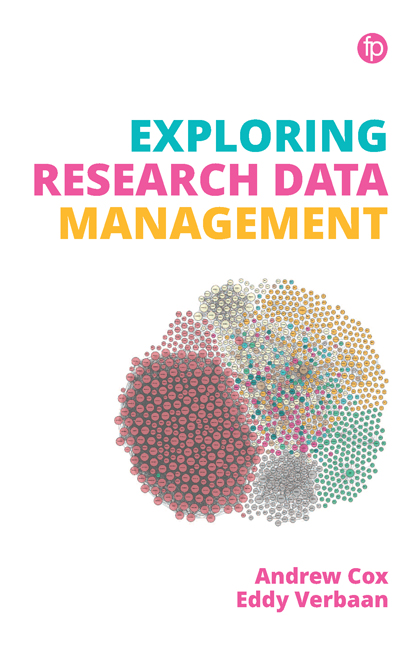Book contents
- Frontmatter
- Contents
- List of tables and figures
- 1 Introducing Research Data Management
- 2 The Social Worlds of Research
- 3 What Are Research Data?
- 4 Case Study of RDM in an Environmental Engineering Science Project
- 5 RDM: Drivers and Barriers
- 6 RDM as a Wicked Challenge
- 7 Research Data Services
- 8 Staffing a Research Data Service
- 9 Requirements Gathering for a Research Data Service
- 10 Institutional Policy and the Business Case for Research Data Services
- 11 Support and Advice for RDM
- 12 Practical Data Management
- 13 Data Management Planning
- 14 Advocacy for Data Management and Sharing
- 15 Training Researchers and Data Literacy
- 16 Infrastructure for Research Data Storage and Preservation
- 17 Evaluation of RDS
- 18 Ethics and Research Data Services
- 19 A Day in the Life Working in an RDS
- 20 Conclusion: the Skills and Mindset to Succeed in RDM
- Index
1 - Introducing Research Data Management
Published online by Cambridge University Press: 21 September 2019
- Frontmatter
- Contents
- List of tables and figures
- 1 Introducing Research Data Management
- 2 The Social Worlds of Research
- 3 What Are Research Data?
- 4 Case Study of RDM in an Environmental Engineering Science Project
- 5 RDM: Drivers and Barriers
- 6 RDM as a Wicked Challenge
- 7 Research Data Services
- 8 Staffing a Research Data Service
- 9 Requirements Gathering for a Research Data Service
- 10 Institutional Policy and the Business Case for Research Data Services
- 11 Support and Advice for RDM
- 12 Practical Data Management
- 13 Data Management Planning
- 14 Advocacy for Data Management and Sharing
- 15 Training Researchers and Data Literacy
- 16 Infrastructure for Research Data Storage and Preservation
- 17 Evaluation of RDS
- 18 Ethics and Research Data Services
- 19 A Day in the Life Working in an RDS
- 20 Conclusion: the Skills and Mindset to Succeed in RDM
- Index
Summary
Aims
The aims of this chapter are to:
• introduce the topic of research data management (RDM) and what it means in practice
• explain the thinking behind the book, so you can use it effectively.
A thought experiment
Imagine going to a busy researcher's office:
• What would you expect to see?
And if you asked them about their research history:
• What would their story be like?
And if you asked them specifically about the ‘data’ that they collect as part of their research:
• What types of data would they say they have?
• How much data would they have?
• How would they store and back up their data?
• Who would they say owns the data?
• Would they say they share the data with others, or not?
Let's offer an answer based on the answers of one of the authors of this book (himself a researcher). Andrew says:
Well, I am embarrassed to say my office is pretty untidy: a table strewn with papers; three bookshelves packed with books, reports, print-outs – a lot relating to research, but also teaching. A filing cabinet, which if you unlock it, is jam-packed with various papers, including some things like hand-drawn maps of an area of Sheffield; a stack of completed questionnaires; a roll of flipchart paper covered with Post-it notes, from a data collection workshop last year. All that is stuff I have gathered for my research. There are quite a few folders of interview transcripts as well. Some go way back! Also in there are some old-looking memory sticks. I wonder what's on them myself!
Of course where I work most of the time is here at the computer. Again, it's going to be hard for me to summarise what is on the computer. Here is a secure network drive where I keep a lot of project work – or used to – alongside files relating to teaching. The university also has a secure Google drive service. There is also a research data server. I guess I basically keep material in folders by project. But quite often it's a bit more complicated than that. For example, I might re-use material across a number of projects.
- Type
- Chapter
- Information
- Exploring Research Data Management , pp. 1 - 10Publisher: FacetPrint publication year: 2018



